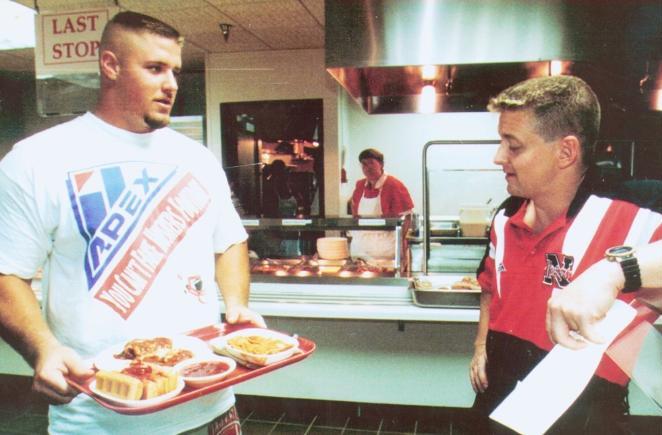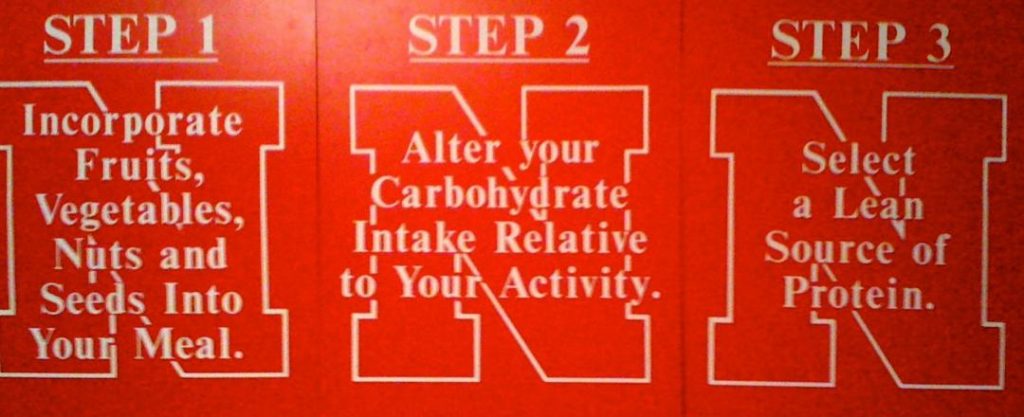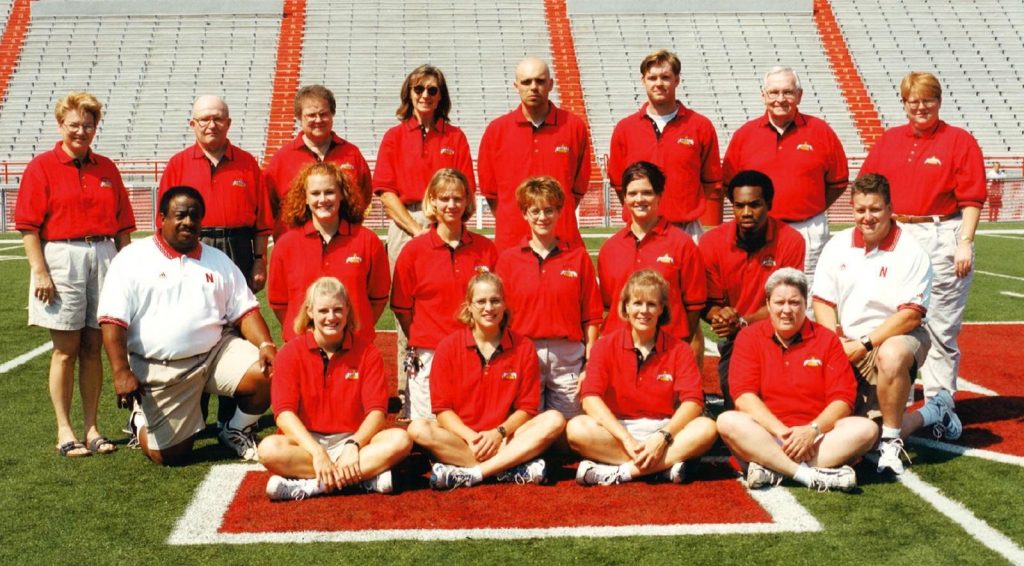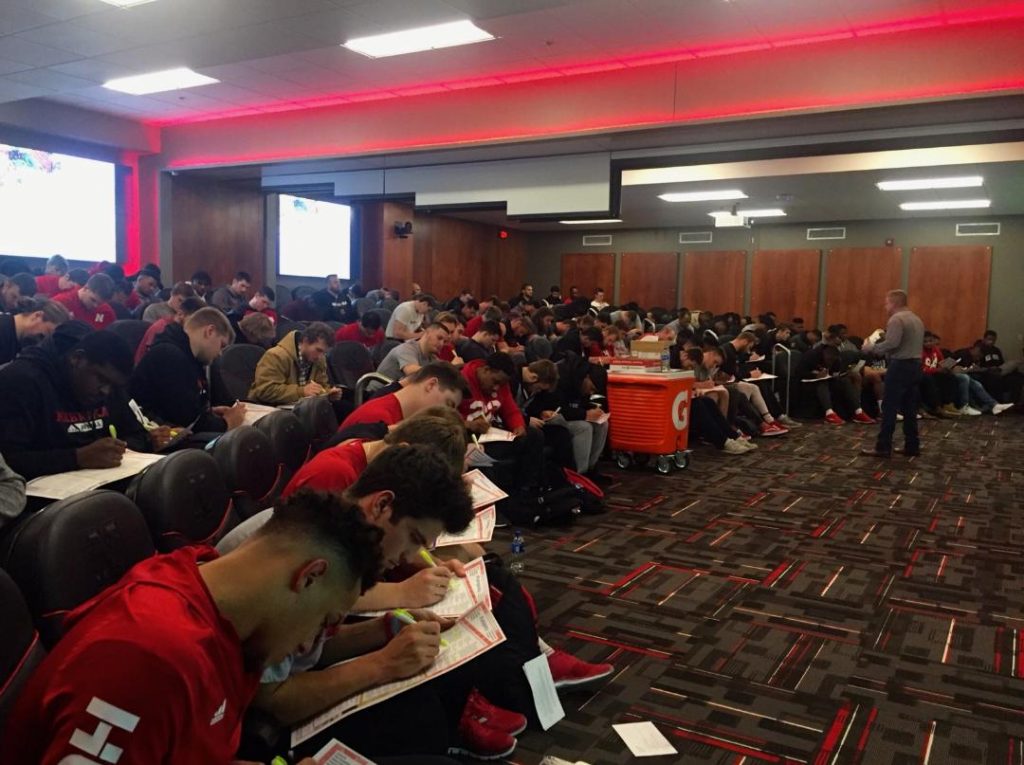Anatomy of an Era: Dave Ellis, Part 2

Excerpted from Chapter 9, No Place Like Nebraska: Anatomy of an Era, Vol. 1
Dave Ellis, Part 2
Sports Nutritionist
Q: 60 wins & 3 losses, Dave. Nebraska football from 1993 to 1997. Almost unheard of in modern day college football…
DE: One of the strongest eras ever. Those were teams that ran the tables and won with style points, literally. And it comes up in every discussion about the best team in the history of college football. I feel very fortunate to have been given those responsibilities and be around during those years, and have an extraordinarily soft spot in my heart for the people who gave me those opportunities, the mentors in my life who had a positive influence there. And the relationships with those athletes and coaches? It was very special.
It was a tough day when we moved away in 2001. I think it was July 2001. Then when we moved out here in 2003 to Colorado. It was very, very hard to not work for that athletic department and still live in Lincoln. It was something that I cared for deeply, but to look at it in the newspaper and TV and radio every minute of every day was very hard, because I kind of knew the handwriting on the wall with regards to what was going down there for Frank. He didn’t deserve it and it was tough to watch.
Q: So you left before Frank was let go?
DE: I left before Frank. I worked for him for a few years, from the time he took the helm to the end of his campaign in the 2001 season.
Q: What led you to leave after 2001?
DE: You know, Darin Erstad, in particular, came back for a game and said, “Hey, I’d love to have you work with me on my nutrition issues.” He was with the Anaheim Angels at the time and I couldn’t do it, just completely booked with my responsibilities at Nebraska, doing some clinical work with the hospitals around town, getting my R.D. at the time. I had never gotten my R.D. so I still had to get that done. And I was just blown away when he told me how much he was willing to pay… and it was half my salary. And I was completely flabbergasted. Here I am, a state employee putting in 12-14 hour workdays, six, seven days a week, for geez…When I left, I was probably on top of the sports nutrition industry, say 50 grand a year. So here a guy offers me 25 grand to do his nutrition. And I’m just doing the math, right? And going, ‘Geez, I could probably see my family more, maybe make more, won’t stretch myself so thin…’
And, quite honestly, I was seeing some bad things in regard to the commitment that was going to keep football on top at Nebraska, as far as priorities in the athletic department. Had Tom been the athletic director I’m sure there would have been a more harmonious transition to Frank, an evolution of things at Nebraska to where the dip they went through never would have happened. But there was time there where priorities were not straight, and when Tom was there Tom was suffering through some of that, too, his last couple of years. So it was awkward. I was watching a good thing start to unravel a little bit, a lot of it was out of the control of what traditionally had been the football staff’s control.
Q: As far as priorities?
DE: Well, it’s one thing to build the skyboxes, but in the end, you know, it was things that directly impact the ability for football to practice appropriately in the cold months. Maybe things that Tom would have liked to evolve, that Frank would have liked to evolve, they were then being reprioritized to fund a banking track out at the Devaney Center. I mean, who knows, football was still paying for everything but football wasn’t getting much of a say as far as those revenues, had they been able to make some of those calls…
Q: Sounds like the typical American taxpayer (laughs)…
DE: Yeah! A lot of what we’re all experiencing right now. I think a good partnership of -what I’ve experienced in athletics- is that an A.D. isn’t an autonomous figure over football or the revenue sports. They’re partners where they say, ”Look, if you don’t succeed and I don’t succeed we’re both gonna be out of here.” Those are the really good dynamics versus the ‘mystery manager’ over the coach, and the coach’s wishes are lost in other priorities or misappropriated priorities.
It’s no secret that Tom and Bill Byrne didn’t see eye to eye on the priorities that were impacting football. When Tom left, I don’t think Frank had as much political capital to work with as Tom, obviously. It was a real sad day when Tom Osborne was not handed the reins as the A.D. when the opportunity came first pass … I’m sure there’s nobody cared more about that state than Tom Osborne.

The three steps (Unknown/Uncredited)
Q: If you were to identify the greatest team need when you first got there in 1994, what sticks out in your mind?
DE: There was a food supply, but the kids didn’t know how to use it. So we partitioned food into three steps: 1) food that keeps you from getting sick, 2) foods that we use for energy, and 3) food that help us resolve muscle soreness. We took the foods and we partitioned the three steps so the athletes could then be educated on how to get something from each of those three steps.
Q: What was it, again?
DE: It was the antioxidants. The first thing the kids come in and see is the fresh produce, whether fresh fruits and fresh vegetables or other great antioxidants like nuts and seeds and olives. We had all those types of foods, and the key was very simple: get some color on your plate. It’s the biggest weakness of a student/athlete’s diet. A lot of them grew up eating meat and starches and they didn’t understand the short-term immune benefits to being committed to those antioxidants in the long term, to disease prevention benefits, that just continued to grow and grow and grow. As far as the peer review research, these concepts are sound.
But when it was all said and done, we made them pick their fresh produce, tried to get away from being just a bunch of meat-and-potato eaters and really sold that into the kids as to why that is important, strengthened the variety there. And of course, there were always carbs around. Carbs are cheap: bread, pasta, rice, potatoes, sugars from beverages, and even some desserts for the athletes. But that wasn’t new, there was plenty of that going on when I got there.
And of course, protein sources, one thing I did was make sure there were more lean options for the kids so on off days when they were injured or sick they were less prone to stumble into a medium- to high-fat source of protein when they could’ve or should’ve been using a leaner source.
So there was a commitment immediately to evolving our food supply, merchandising it using these three steps, and then changing the way we were feeding incidental to competition on the road, during two-a-days. And, of course, also coming up with a cost effective supplement program where we literally made our own version of Gatorade, our own version of GatorPro, a post workout recovery shake. We brought in more sophisticated programs for connective tissue remodeling, brought in some work- and weight gain-advantages with creatine for individuals who were candidates, who wanted to gain weight in the offseason by taking on more reps in the weight room where we were focused on adding muscle, you name it.
We had implemented a lot of big things there, but none bigger than our commitment to feeding these athletes at home and on the road. And when we couldn’t use solid foodstuff we’d be using a liquid-soluble form of calories that was well-timed, incidental to training and recovery purposes.

Husker Nutrition & Training Table Staff 2001 (Nebr. Sports Info)
And all that together was quite new. There was just a lot going on. And when the coaches started to say, ”Look, we’ve thrown every rep at ’em in practice that we’ve ever thrown and more, and the kids are standing there looking at us like, “What next?”“ (laughs) Those were the kind of feedback I was getting from Milt Tenopir or whomever. They were throwing everything they’ve got at these kids in practice and these kids are taking it and looking for more, not even on their knees. I got that feedback by the end of the first season. So it was a deal where it didn’t take long for our coaches to come around, because they liked to win.
And if Nebraska was anything, it was a ‘rep factory’ where our walk-on program allowed our Ones and Twos to go live on the Threes and Fours, minimize the chances the Ones and Twos were going to hurt each other because they were beating up on the Threes and Fours. And we out-repped the country on the football field like no other. So really, all Boyd and you guys had to do was get the guys bigger and stronger, and then the football coaches finished them off with a very sport-specific conditioning program called reps… and a lot of them.
Q: High-intensity reps, too…
DE: Yeah. Nobody could touch us with regards to our practice reps in the week because of our ability to rep on Threes and Fours. So we didn’t have to be horribly sophisticated with our speed and agility and conditioning activities, because Osborne had the ability to get a lot of that done for us. We just had to have them in the ballpark. If we had them 80% of the way, believe me, the coaches were going to finish them off the second they put pads on these guys. And hey, Tom is a gentleman and a scholar and a leader, but man, and I will tell you, nobody took a pound of flesh harder in practice than that staff. They weren’t afraid to rep these kids.
Q: Do you have a favorite team from those years that stands out more than another?
DE: I think winning in Miami the first year was a real accomplishment, it really was. The Fiesta Bowl against Florida was a fashionable win like no other, an ass-kicking. And it was against my old roommate Schmitty, who was working as the strength coach for Spurrier at the time, and it goes down as one of the biggest polish-up jobs that I’ve ever been involved in, to where we went undefeated and won with the kind of style-points where everybody was going, “Holy smokes!” So those two stick out to me the most, but the kids were special on all three of those teams. And there was an element of luck, as you saw, in every one of those seasons.
But I think the first one –’94- was not as skilled a group of kids as the last two national championships: they won a little bit more on guts and toughness. But man, they were all great groups. What I recognize about Midwest kids is that there’s nothing that scares them. Wherever those kids came from -in the entire country of ours- they learned how to practice in the heat, they learned how to practice in the cold, they worked themselves from that old, crappy locker room in that north stadium into the south stadium and, believe me, they didn’t want to go back there (to the north stadium locker room).
The whole thing worked, it really did. To this day I still counsel teams that design the new palaces and to-die-for locker rooms. I tell them to have some old, crappy locker room, somewhere that every once in a while you can send somebody back to if they get a little selfish and forget what it takes to contribute to their team. That there wouldn’t be a bad place for everybody to start at, because those were some humbling months and years for some of those guys down in that old locker room, with a grumpy guy like Walt (Johnson) washing your jock once a week. (laughs) That model -and it wasn’t by design- it was just that they couldn’t fit them all into that one place. But it was actually a hell of a model.
And there are a lot of problems now with selfish kids who are all style and all flash, who progress from one level to the next based on their skills, but they’re really not tough, they’re really not big-time competitors, they really don’t know what to do with their backs against the wall. They succeeded because they had exemplary skills, but they didn’t have the backbone with it. And that’s become a huge problem in athletics now. And those type of teams that get assembled with all that flash? When their back’s against the wall they can’t look each other in the eye with credibility and say, ”Hey, we’ve had worse. Not a problem. Let’s go! We’ve dealt with worse than this. We’re prepared for this. No problem.” They’re instead saying, “Well, I guess this is my last game in college. I don’t want to get hurt. My agent’s waiting for me in a limo outside. I’m going pro. Let’s see if I can just fake an injury and get out of this game.” That’s the kind of crap that’s going on now.
None of that crap went on when we were dealing with those three national championships. Every one of those kids was committed to being a contributor, succeeding and finishing, and doing something extraordinary for their team and their families and the alumni of that school so that they would remember.

Great Move, Coach Frost: Dave Ellis instructing today’s Huskers (Unknown Source)
Q: And if you took a play off in practice somebody would beat the living crap out of you, right? (laughs)
DE: There was somebody that would challenge you out on the field, and when that locker room door shut there was someone man enough to make sure they’d get the message out there. They got that message in the locker room. And I knew when that stopped happening, because Nebraska made a change for the worse. Remember that one game where Eric Crouch almost got his head torn off at that game against Kansas State?
Q: I‘ve got that picture in my office.
DE: It might have been that K-State game where (Equipment Manager) Glenn Abbot packed like only 20 freaking capes. It was ridiculous. Here we are in a sleet storm and we have just enough capes to cover the 11 starters on offense and the 11 starters on defense. And it’s freezing. It’s literally raining sleet, and we’re standing there ill-equipped to cope with this as a team. It was a bad day: the officials aren’t calling anything, everybody was in on it, you know? (It was one of those classic K-State deals, having somebody rifling through the garbage cans at the hotel, had somebody rifling through the bags in our locker rooms, everybody in that whole town was in on that deal. They were gonna get us that trip. The reason I know? Mike Stoops. It was because Mike Stoops was on that team, so I got the lowdown on it later when he was at Oklahoma with his brother.) And the bottom line is, I’m standing on the sidelines and we’re trying to get a cape for the starters who came off that field hot and sweaty so they could kind of stay warm without going back out there and pulling up lame on us or get sick.
And I found myself in a battle to get capes away from guys who were not gonna play that day but were on the roadtrip and who didn’t care enough about their own teammates to give that cape up. And I’d never experienced that from the day I arrived at Nebraska, had never experienced selfishness before, because on game day everybody in that locker room and on that sideline was dedicated to doing whatever it took to get a win. Now, as trivial as that sounds, I knew right there on the spot, ’This is not good. I’ve never seen this. I’ve never seen somebody not sacrifice and contribute to this team’s whole potential to win a game because they were too selfish, because they wanted something more than considering the needs of the starters.’ It was just weird, just like an iron anvil hitting you on the head, it wasn’t good.
I know the number one job of being a head coach in athletics is to spot selfishness, break it down before it infected anybody else, because this was truly the cancer and the nemesis and the start of the unraveling of the fabric that I really thought characterized Nebraska, okay? They had each other’s backs all those years. We had the kids who were getting the rings, going to the bowl games and getting things, going right to the good locker room. And guess what, they didn’t have any clue what it really took to go out there and have all that success, who just wanted all the benefits and had never learned along the way what the ‘sacrifice’ piece was all about, what the ‘paying your dues’ piece was all about, having to humble yourselves to anything. And I think we still had the north locker room at that time, but it was just something along the way that some kids were slipping through some cracks, they were being cow-towed to.
You think about Charlie McBride; There was probably not a kid Charlie McBride ever brought in, no matter how highly recruited they were, how big a stud they were, that Charlie didn’t make them earn his respect and work their way up through the trenches. That’s why those guys played so hard for Charlie. You couldn’t understand a word he was saying at halftime when his teeth were coming out and he was spitting bubbles, but I promise you, every guy in that locker room would have run through a wall for that guy, because by the time you were a starter for him you had earned it. We were missing some of that, and that might have been my last year, that Kansas State game. Do your homework on that. I think that might have been the last year. That might have been when I knew, where I said, ‘It ain’t good.’
Q: The ship’s going down. Jump off?
DE: It wasn’t so much ‘the ship’s going down and jump off’, so much. It was, ‘Okay, things are gonna be harder to succeed here based on the dynamic between the administration and football and the kind of kids that were coming up through the ranks, the selfishness.’ I could tell we had seen some better days, and knowing what was waiting for me out there, I was intrigued to test the waters, you know?
Copyright @ 2013 Thermopylae Press. All Rights Reserved.
Photo Credits : Unknown Original Sources/Updates Welcomed
Paul Koch